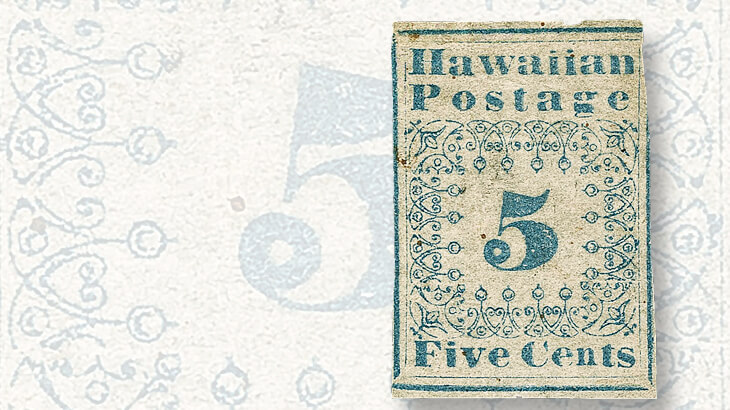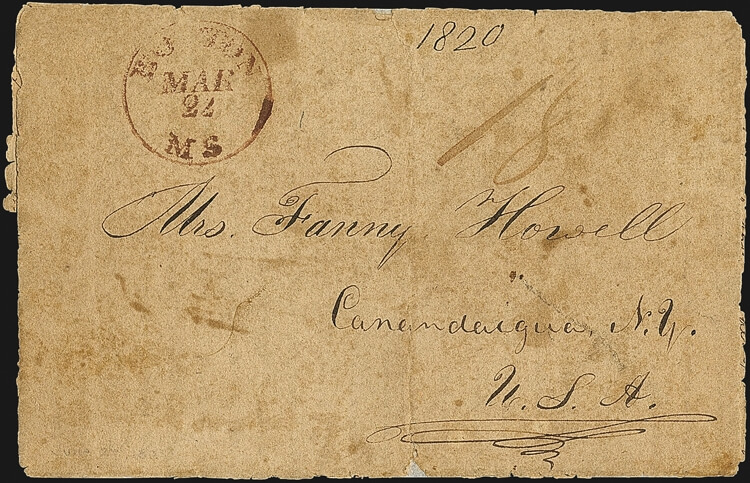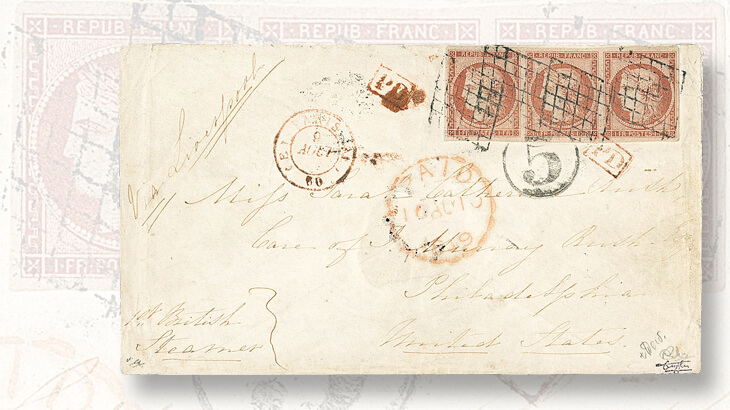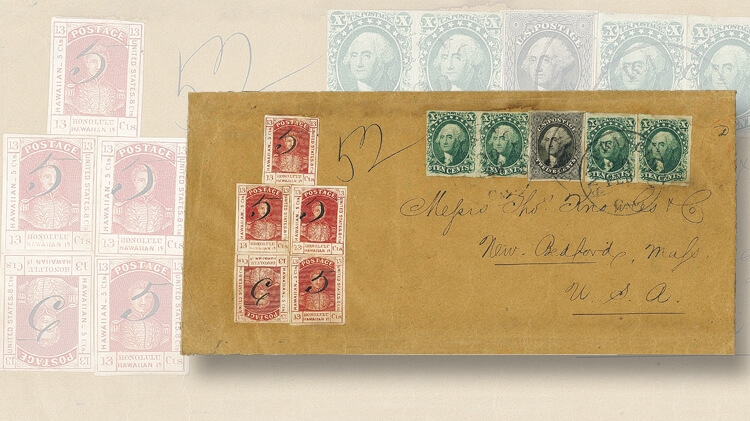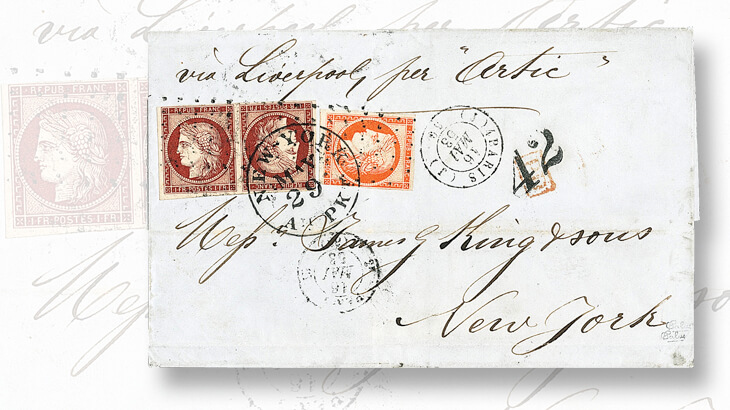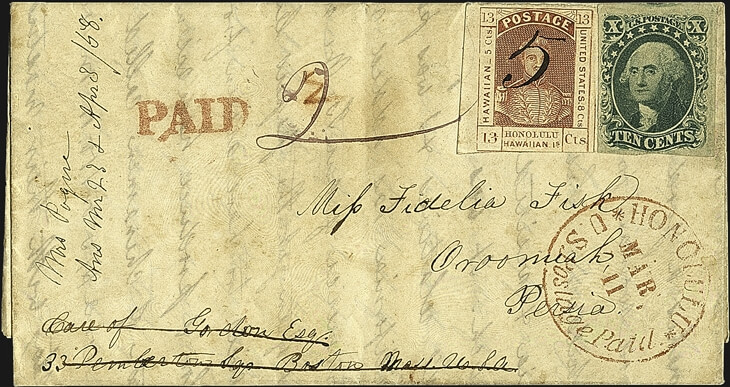Auctions
1857 cover bearing five examples of remarkable stamp tops $250,000 in Siegel sale
By Matthew Healey, New York Correspondent
They came, they saw, they raised their paddles.
For the tens of thousands of visitors attending World Stamp Show-NY 2016, a remarkable string of auctions by five different firms over six days brought excitement and opportunity during late May and early June.
Robert A. Siegel Auction Galleries kicked off the action on Sunday, May 29, with a pair of big-name sales: the William H. Gross collection of Hawaii, and the second part of the Steven Walske collection of trans-Atlantic mail between the United States and France.
Christoph Gaertner, of Germany, picked up the gavel on Monday, May 30, with a day-long session devoted to worldwide rarities that included an impressive selection of U.S. and Confederate postmasters’ provisionals.
Siegel resumed on Tuesday, May 31, with a record-breaking sale of the highest-graded example of the iconic American airmail rarity, the Inverted Jenny, followed by other U.S. rarities.
Wednesday, June 1, saw Schuyler Rumsey celebrate his firm’s 20th anniversary with a sale of U.S. and worldwide rarities, including U.S. Official issues collected by Robert L. Markovits, while Thursday saw the Daniel F. Kelleher firm’s offering of the Alfred J. Capurro collection of worldwide, mostly mint stamps.
H.R. Harmer, a member of the Global Philatelic Network, wrapped things up on Friday, June 3, with the award-winning Erivan Haub collection of U.S. and Confederate postmasters’ provisionals, among many other items.
Linn's Stamp News is breaking them all down in a multi-part U.S. Auction Roundup series:
Christoph Gaertner, May 30 | Robert A. Siegel, Part II, May 31 | Schuyler Rumsey, June 1 | H.R. Harmer, July 3
The sale of the Gross collection of Hawaii was previously reported in the June 2 daily edition of Linn’s Stamp News prepared and distributed to attendees while World Stamp Show-NY 2016 was still going on. It included rarities from the earliest “Missionary” issues of 1851 up to rare provisional-government overprint errors of 1893.
As with all seven previous auctions of Gross’s worldwide stamp collection and the recent private-treaty sale of his Swiss collection, proceeds went to charity — in this case, the Hawaii Foodbank and the Smithsonian’s National Postal Museum, among others.
The sale was arranged and conducted for Siegel by the team of Charles Shreve and Tracy L. Carey, who have worked with Gross for two decades to build and then disperse his stamp holdings.
Connect with Linn’s Stamp News:
Sign up for our newsletter
Like us on Facebook
Follow us on Twitter
The sale began with prestamp postal history, including an 1820 cover that was said to have been the first letter to arrive back in the United States from missionaries in what were then called the Sandwich Islands. A modest starting bid of $13,000 was quickly run up to double that amount, with Carey hammering it down for $26,000, plus the 15 percent buyer’s premium Siegel adds to all lots, for a total of $29,900.
Hawaii’s first stamps of 1851, known as the “Missionaries,” were well represented in the Gross collection by both unused and on-cover examples.
An unused 5¢ Missionary (Scott 2), with a small “n” in “Cents” and the only sound 5¢ out of a total dozen known, sold for $46,000. Three covers bearing this stamp went for prices ranging from $51,750 to $97,750.
The absolute highlight of the sale was the storied 1857 cover bearing a remarkable five examples of a provisional “5” manuscript surcharge on the 13¢ King Kamehameha III issue (Scott 7), along with four U.S. 10¢ stamps of 1855 (14, 15) and a 12¢ of 1851 (17). The mixed franking paid the quintuple rate for postage from the islands to California and thence to Massachusetts, plus a 2¢ ship captain’s fee. After spirited bidding, it sold for $253,000.
Another cover with a single Hawaii 5¢ provisional and U.S. 10¢ stamp, mailed in 1857 to a missionary in the extraordinary destination of “Oroomiah, Persia” (today Urmi, Iran) sold for $138,000.
With every item selling and winning bids well distributed among more than two dozen buyers, the total hammer was $1,576,575, or just over $1,813,000 with the buyer’s premiums.
The room was packed with French speakers for the Walske sale, including three generations of the well-known Behr family of Parisian stamp dealers and auctioneers, whose paddle went up frequently as Siegel president Scott Trepel called the sale.
The Walske collection documented every rate and route combination taken by the mails between the United States and France from 1840 to the advent of the Universal Postal Union in 1875. This time span covered a wide range of complex and hard-to-decipher frankings and markings, and the result was a testament to Walske’s philatelic scholarship.
Highlights included a magnificent 1853 cover sent from Paris to Groton, Mass., via New York, franked with a strip of six of the 1-franc value from France’s first issue, the Ceres design of 1849, in a special shade of cherry-red known as cerise (variety of Scott 9). Completing the franking was a pair of 25-centime President Louis Napoleon stamps (11).
Early stamps of many countries were essentially handmade, and France’s were no exception. The colors of ink used could vary considerably, and specialist collectors, after extensive study, can often assign particular shades of color to particular printings and periods of use. The cerise shade of the 1fr has only been recorded as having been used in Paris during August 1853.
Adding to the cover’s interest is the fact that it left France as a quintuple-rate letter, but on reaching the U.S. was assessed for American postage at a quadruple rate, owing to the different systems of weights and measures in each country. This is indicated by the large “20” stamped on the cover, meaning 20¢ was due: Letters could not be fully prepaid by their senders at that time, so each country collected its share of the postage.
“Steven keeps saying this is his favorite cover, and after looking at it for so long, it’s become my favorite too,” announced Trepel, before gaveling it for $30,000, or $34,500 with premium.
Among classic stamps of France, the collecting of tete-beche pairs has been popular since the 19th century.
Tete-beche, which means “head-to-tail” in French, refers to pairs in which one stamp is upside-down in relation to the other. In the case of the Ceres issue, this occurred accidentally when one impression in a printing plate had to be repaired, and would be carelessly replaced inverted. Sometimes, inverted pairs wound up on cover, and these are highly desirable.
An 1850 cover with a tete-beche pair of the 1fr dark carmine (Scott 9a), sent to New York on the steamer Arctic (which later sank with the loss of hundreds of lives), sold for $63,250.
The high realization of the sale went to a letter carried via Liverpool to Philadelphia and franked with a strip of three of the scarce dull vermilion shade of the 1fr Ceres (variety of Scott 8).
This pale shade was only in use briefly during 1849, and there was only a four-month window when this stamp could be used to prepay letters overseas. Just five covers sent outside France survive with this shade, and only one to the United States. Additionally, it is the second-largest multiple of this shade known on cover. Called “the highlight of the Walske collection,” it sold for $97,750.
After you finish the U.S. Auction Roundup, check out our International Auction Roundup:
Christoph Gaertner’s WSS-NY 2016 auction totals $5.74 million
Kelleher’s WSS-NY 2016 sale topped by high-denomination World War I-era overprint
H.R. Harmer sells first piece of mail from the first German expedition to Antarctica
MORE RELATED ARTICLES
Headlines
-
US Stamps
Oct 7, 2024, 12 PMVasiliauskas named president of Mystic Stamp Co.
-
US Stamps
Oct 6, 2024, 5 PMApgar souvenir card available
-
US Stamps
Oct 6, 2024, 4 PMFirst Continental Congress and U.N. stamps receive Scott catalog numbers
-
World Stamps
Oct 5, 2024, 1 PMCanada Post continues Truth and Reconciliation series
